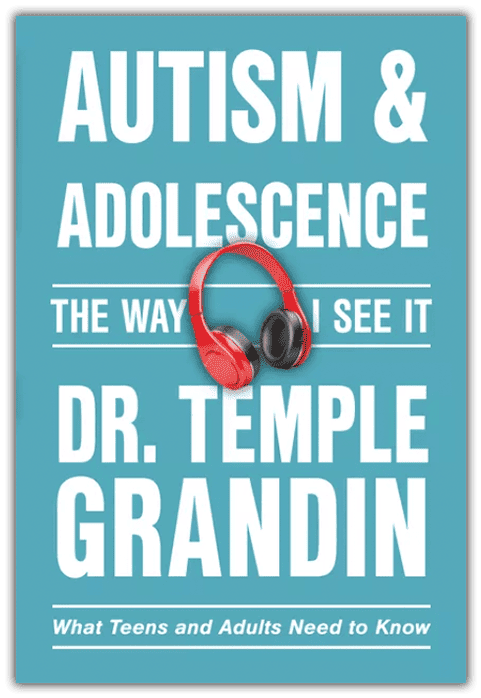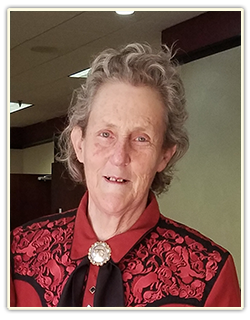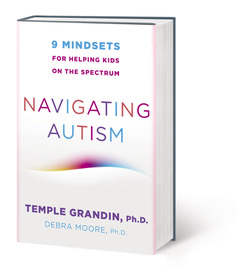
Webinars & Conferences
Upcoming Conferences
June 17 - Stamford, CT
June 28 - Jacksonville, FL
July 29 - Denver, CO
August 14 - Harrisburg, PA
August 18 - Webinar
August 20 - New Orleans, LA
September 10 - Dallas Forth Worth
September 15 - Missoula, MT
September 19 - Cincinnati, OH
A MUST LISTEN!!
Temple's Latest Books!
Temple Grandin earns Dole Leadership Prize!
NAVIGATING AUTISM
"The Outdoor Scientist"
Too Much Screen Time has a
Bad Effect on Child Development
At conferences, more and more parents of a recently diagnosed teen or elementary school child have told me that they may be on the autism spectrum. In some cases, they have an official diagnoses and in other cases, they do not. Almost all the parents who have been told they are on the autism spectrum have worked successfully in a variety of occupations. The question is: why was their life relatively successful and their child is now having problems with a lack of friends, bullying or is extremely hyper and anxious? In most of these cases, the child had no early childhood speech delay as a toddler. When I was in college, I had friends that today would be labeled as having autism.
There may be two reasons why both these mildly autistic parents and my geeky classmates got and kept decent jobs.
- Learning how to work at a young age. I have written extensively about this.
- In my generation, kids played outside with their peers and learned social interactions. They were not glued to electronic screens.
In the September/October 2016 Carlat Report of Child Psychiatry, I read two articles that were a great “light bulb” moment. One was written by Mary G. Burke, M.D., psychiatrist t the Sutter Pacific Medical Foundation in San Francisco and the other was an interview with Michael Robb, Ph.D. of Common Sense media. Dr. Burke explained that both babies and children need to engage with other people who react to their behavior. The problem with watching endless videos is that the video does not react to the child’s responses. Today, Michael Robb recommends no more than 10 hours of screen time a week until the kids are in high school. This is the same rule my mother enforced for TV watching.
Electronic Device Free Times
Both specialists recommend that every family should have specific electronic device free times so they can interact and talk. There should be at least one device free meal per day where both parents and children turn off and put all electronic devices away. In her practice, Dr. Burke has observed that reducing use of electronics improves symptoms of OCD, panic attacks, and hyperactivity. A report from The Centers of Disease Control reported that in a four-year period from 2003 to 2007, attention deficits increased 22%.
Children and families need times where they can interact without interruption from screens. One study showed that a session of five days at an outdoor nature camp with no electronics improved the ability of middle school children in reading non-verbal social cues. A farmer who ran a summer camp for 8 to 11-year-olds had an interesting observation. During afternoon periods of free play in a walnut orchard, the boys sulked around for two days. On the third day she said a switch flipped and they discovered free play. My three recommendations are:
- Have one electronic device free meal where EVERYBODY including parents puts away all screens.
- Limit video watching, video games and other non-school screen time to 10 hours a week.
- Engage the entire family in activities where people have to interact with each other.
Video Game Use 2019 Update
The people who make electronic media in Silicon Valley are greatly restricting their children’s use of video games and video watching. Two articles in the New York Times and BusinessInsider.com clearly show that the people who create the technology are concerned about their own children’s use of the devices. Research is now showing that people on the autism spectrum are at a greater risk of developing video game addictions. When I talk to parents at autism meetings, I am observing two pathways for fully verbal young adults. The ones with the best outcomes learn how to hold a job before graduation from either high school or college. The ones with the poorest outcome may play video games for 3 to 8 hours every day. Some of these kids have not been taught basic skills, such as shopping by themselves.
There are a number of papers that show that games where teens can talk to their friends can have some positive effects. Low to moderate use of multiplayer games would be one hour a day on weekdays and two hours a day on weekends. These games, when used in moderation, may help a child have friends. Children need to be taught to plan their play so that they do not have to stop in the middle of a Fortnite match. To do this, they may have to have no video games on one night in order to have sufficient time to complete a match on the next night.
There will be some children where getting them to disengage form a video game becomes so difficult that the games may have to be banned. A free paper is available online titled “Measuring DSM-5 Internet Gaming Disorder: Development and Validation of a Short Psychometric Scale.” It has nine questions to help determine if an individual has problem video game use. Some of the intergaming disorder questions are:
- Feeling more irritability, anxiety or sadness when an attempt is made to reduce video game use.
- Loss of interest in other hobbies or activities.
- Jeopardizing jobs, education or career.
References
Bowles, N. (2018) A dark consensus about screens and kids begins to emerge in Silicon Valley, New York Times, October 26, 20108.
CDC Mobility Mortal Weekly Report (2010) (44):1439-1443. Increased 7.8% to 9.5% 2003-2007, 21.8% increase in four years.
Engelhardt, C. et al. (2017) Pathological game use in adults with and without autism spectrum disorder, Peer Journal 5:e3393.
Increasing prevalence of parent reported attention deficit/hyperactivity disorders among children, United States 2003-2007.
Kuss, D.J. et al. (2018) Neurobiological correlates in internet gaming disorder: A systematic literature review, Frontiers in Psychiatry, 9:166 10:3389/fpsyt.2018.00166.
Mazurck, M.O. et al. (2015) Video games from the perspective of adults on the autism spectrum disorder, Computers in Human Behavior, 51:122-130.
Pontes, H.M. et al. (2014) Measuring DSM-5 internet gaming disorder: Development and validation of a short psychrometric scale, computers in human behavior, http://dx.doi,org/10.1016/j.chb.2014.12.006.
Stone, B.G. et al. (2018) Online multiplayer games for social interactions of children with autism spectrum disorder: A resource for inclusive education, International Journal of Inclusive Education, pp. 1-20.
Sundburg, M. (2017) Online gaming loneliness and friendships among adolescents and adults with ASD. Computers in Human Behavior, https://doiorg/10.1016/j.chb.2017.10.020.
Uhls, Y.T. et al. (2014) Five days at outdoor education camp without screens improves preteen skills with nonverbal emotion cues, Computers and Human Behavior, 39:387-392.
Welles, C. (2018) Silicon Valley parents are raising their kids tech free and it should be a red flag, BusinessInsider.com
About Temple Grandin
Dr. Grandin did not talk until she was three and a half years old. She was fortunate to get early speech therapy. Her teachers also taught her how to wait and take turns when playing board games. She was mainstreamed into a normal kindergarten at age five. Oliver Sacks wrote in the forward of Thinking in Pictures that her first book Emergence: Labeled Autistic was “unprecedented because there had never before been an inside narrative of autism.” Dr. Sacks profiled Dr. Grandin in his best selling book Anthropologist on Mars.
Dr. Grandin became a prominent author and speaker on both autism and animal behavior. Today she is a professor of Animal Science at Colorado State University. She also has a successful career consulting on both livestock handling equipment design and animal welfare. She has been featured on NPR (National Public Radio) and a BBC Special – "The Woman Who Thinks Like a Cow". She has also appeared on National TV shows such as Larry King Live, 20/20, Sixty Minutes, Fox and Friends, and she has a 2010 TED talk. Articles about Dr. Grandin have appeared in Time Magazine, New York Times, Discover Magazine, Forbes and USA Today. HBO made an Emmy Award winning movie about her life and she was inducted into the American Academy of Arts and Sciences in 2016.
When she was young, she was considered weird and teased and bullied in high school. The only place she had friends was activities where there was a shared interest such as horses, electronics, or model rockets. Mr. Carlock, her science teacher, was an important mentor who encouraged her interest in science. When she had a new goal of becoming a scientist, she had a reason for studying. Today half the cattle in the United States are handled in facilities she has designed.




